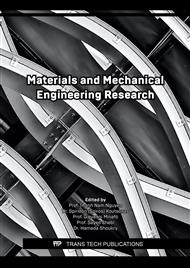[1]
Matthew J. Donachie and Stephen J. Donachie, SUPERALLOYS: A Technical Guide, ASM International, (2002).
Google Scholar
[2]
Timothy P. Gabb, Rebecca A. MacKay, Susan L. Draper, Chantal K. Sudbrack, and Michael V. Nathal, The Mechanical Properties of Candidate Superalloys for a Hybrid Turbine Disk, NASA/TM—2013-217901.
Google Scholar
[3]
J. Gayda, T.P. Gabb, P.T. Kantzos, "The Effect of Dual Microstructure Heat Treatment on an Advanced Nickel-Base Disk Alloy, Proceedings of the International Symposium on Superalloys 2004, pp.323-329.
DOI: 10.7449/2004/superalloys_2004_323_329
Google Scholar
[4]
T.P. Gabb , P.T. Kantzos, J. Telesman, J. Gayda, C.K. Sudbrack, B. Palsa, Fatigue resistance of the grain size transition zone in a dual microstructure superalloy disk, International Journal of Fatigue, 2011, Vol. 33, No. 3, Pp. 414–426.
DOI: 10.1016/j.ijfatigue.2010.09.022
Google Scholar
[5]
R. R. Ye, H. Y. Li, R. G. Ding, T. J. A. Doel, S. Bray, A. Walpole, P. Bowen, Microstructure and microhardness of dissimilar weldment of Ni-based superalloys IN718-IN713LC, Materials Science and Engineering: A, Vol. 774, (2020).
DOI: 10.1016/j.msea.2019.138894
Google Scholar
[6]
O. N. Senkov,D. W. Mahaffey, S. L. Semiatin, Effect of process parameters on process efficiency and inertia friction welding behavior of the superalloys LSHR and Mar-M247, Journal of Materials Processing Technology, 2017, Pp 156-168.
DOI: 10.1016/j.jmatprotec.2017.07.020
Google Scholar
[7]
T. H. Tra, M. Okazaki, Creep-Fatigue Cracking Near the Welded Interface in Friction Welding Dissimilar Superalloys INCONEL 718 and MAR-M247, Metallurgical and Materials Transactions A, 2017, 48, 8, p.3692–3701.
DOI: 10.1007/s11661-017-4151-5
Google Scholar
[8]
Jilin Xie, Yingche Ma, Min Wang, Haoze Li, Naiwen Fang, Kui Liu, Interfacial characteristics and residual welding stress distribution of K4750 and Hastelloy X dissimilar superalloys joints, Journal of Manufacturing Processes, Vol. 67, 2021, pp.253-261.
DOI: 10.1016/j.jmapro.2021.05.001
Google Scholar
[9]
Seyedmohammad Tabaie, Farhad Rézaï-Aria, Bertrand C.D. Flipo, Mohammad Jahazi, Dissimilar linear friction welding of selective laser melted Inconel 718 to forged Ni-based superalloy AD730™: Evolution of strengthening phases, Journal of Materials Science & Technology, Vol. 96, 2022, pp.248-261.
DOI: 10.1016/j.jmst.2021.03.086
Google Scholar
[10]
Wenhua Dai, Sun Wenjun, Jijun Xin, Shanlin Wang, Chao Fang, Jing Wei, Weldability and mechanical properties of IC10 single crystal and GH3039 superalloy dissimilar laser beam welding joint, Materials Science and Engineering: A, Vol. 791, (2020).
DOI: 10.1016/j.msea.2020.139797
Google Scholar
[11]
Peihao Geng, Guoliang Qin, Hong Ma, Jun Zhou, Ninshu Ma, Linear friction welding of dissimilar Ni-based superalloys: microstructure evolution and thermo-mechanical interaction, Journal of Materials Research and Technology, Vol. 11, 2021, pp.633-649.
DOI: 10.1016/j.jmrt.2021.01.036
Google Scholar
[12]
Wenjun Sun, Shanlin Wang, Jijun Xin, Guanhua Tan, Min Hong, Ming Wu, Liming Ke, Microstructure and mechanical properties of the IC10/GH3039 dissimilar electron beam welded joint, Vacuum, Vol. 181, (2020).
DOI: 10.1016/j.vacuum.2020.109592
Google Scholar
[13]
William Reeks, Helen Davies, Silvia Marchisio, A Review: Interlayer Joining of Nickel Base Alloys, Journal of Advanced Joining Processes, 2020, 100030, in press.
DOI: 10.1016/j.jajp.2020.100030
Google Scholar
[14]
M. Okazaki, M. Sakaguchi, T.H. Tra, M. Sekihara, Creep-fatigue and thermo-mechanical fatigue of friction-welded IN718/MarM247 dissimilar joint, Superalloys 2008, pp.221-228.
DOI: 10.7449/2008/superalloys_2008_221_228
Google Scholar
[15]
C.J. Boehlert, D.S. Dickmann, and N.C. Eisinger, The Effect of Sheet Processing on the Microstructure, Tensile, and Creep Behavior of Inconel Alloy 718, Metallurgical and Materials Transactions A 2006, 37A, pp.27-40.
DOI: 10.1007/s11661-006-0149-0
Google Scholar
[16]
R. Damodaram, S. Ganesh Sundara Raman, K. Prasad Rao, Hot tensile and stress rupture behavior of friction welded alloy 718 in different pre-and post-weld heat treatment conditions, Materials Science & Engineering A, 2013, 560, p.781–786.
DOI: 10.1016/j.msea.2014.06.076
Google Scholar
[17]
R.L. Huddleston, Assessment of an improved multiaxial strength theory based on creep- rupture data for Inconel 600, SciTech Connect, conf-930702—44 (1993).
DOI: 10.2172/10168640
Google Scholar
[18]
M.W. Spindler, The multiaxial creep ductility of austenitic stainless steels, Fatigue and Fracture of Engineering Materials and Structures, 27, 4, pp.273-281 (2004).
DOI: 10.1111/j.1460-2695.2004.00732.x
Google Scholar


